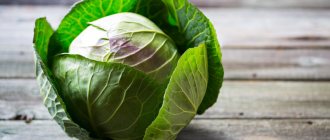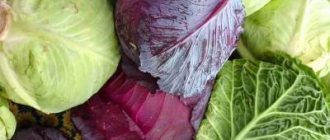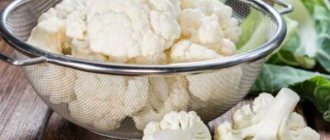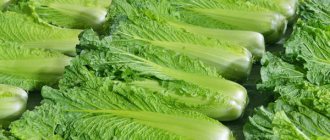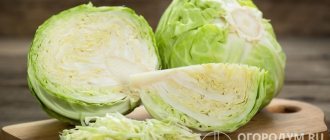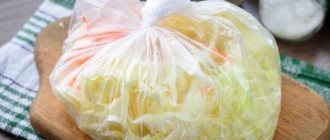Cauliflower is a healthy vegetable that can be used in preparing various dishes. In order for a vegetable to retain its properties, it must be stored correctly.
In a city apartment, the optimal place for this is the refrigerator.
How to properly store cauliflower in the refrigerator so that it does not darken, what is the maximum shelf life of the vegetable at home, read the article.
Preparing for storage at home
Properly collected cabbage heads are suitable for storage . They are harvested during the growing period, preventing the crop from becoming overripe. The heads should weigh between 0.3-1.2 kg.
If the fork is crumbly, yellow in color, does not hold its shape and is limp, it is not suitable for long-term storage. A vegetable that has outgrown the harvest time loses a significant part of its nutrients.
Cabbage is harvested in dry weather.
The cut inflorescences should be immediately transferred to the shade so that they do not begin to wither. Procedure for preparing cabbage:
- Remove dense stalks.
- Remove outer yellowed leaves.
- If there are sprouted leaves, they are removed.
- Rinse.
- Dry.
Vegetable inflorescences are demanding in terms of maintenance conditions. The duration of lying down directly depends on their compliance.
Storing cauliflower in the freezer
Cauliflower is a source of nutrients that people need all year round. Since the vegetable grows only in summer, it is advisable to freeze the heads of cabbage for the autumn-winter period.
But first, you need to prepare your cauliflower for storage, avoiding common problems.
Can it be stored in the freezer?
Cauliflower requires special preparation for storage in both the refrigerator and freezer.
Important. First of all, you need to select heads of cabbage suitable for freezing. The inflorescences should be elastic, milky white, without yellowness. Young leaves and shoots do not need to be removed.
If, when examining the inflorescences and stems, black spots, lethargy or softness are noticeable, this may indicate fungus and mold. Such heads of cabbage cannot be frozen or left in the refrigerator for a long time. It is recommended to trim the affected areas.
How long is it stored?
Freezing significantly extends the shelf life of cabbage. Heads of cabbage can lie in the chamber from two months to one year, provided that the temperature in the compartment is always at the same level:
- at -12°C cabbage can be stored for up to two months;
- at -18°C – until the summer harvest.
The lower the temperature in the freezer, the longer the inflorescences last, but the optimal range is considered to be -17 to -20°C.
Important. If for some reason the heads of cabbage have been thawed, they cannot be re-heated. Repeated storage in the freezer will lead to a change in the color and aroma of the vegetable, loss of taste and benefits, and the appearance of bitterness. In some cases, such a product becomes dangerous to the health of children and adults.
How to freeze correctly
There are several popular ways to freeze cauliflower:
- fresh;
- boiled;
- with broccoli.
Each of these methods requires certain preparation, so before freezing you should familiarize yourself with all the methods and choose the most suitable one for yourself.
To store raw cauliflower you will need:
- Trim the leaves and young seedlings, break the head of cabbage into inflorescences and place in a cup of cold salted water for 5-7 minutes.
- Place dry cotton napkins or clean towels on the table and place pieces of cabbage on them.
- When the fabric absorbs moisture, place the inflorescences in a container prepared in advance.
You can place cauliflower in plastic bags specially designed for freezing. Conventional ones quickly tear at low temperatures, and vegetables scatter throughout the chamber.
To prevent such problems, it is better to keep cabbage in plastic containers with an airtight lid. Then getting a few inflorescences for preparing a dish will not be difficult.
To store boiled cauliflower you need:
- Rinse the heads of cabbage under running water, remove the leaves and chop them coarsely.
- For blanching, prepare two pans: one with boiling water and one with cold water.
- Cook the cauliflower for three minutes over low heat. Then immerse in cold water, immediately remove and place on napkins.
- When the cabbage dries, put it in bags or containers, and then put it in the freezer for long-term storage.
The heads of cabbage should not soften in boiling water; they remain elastic and hard, having gone through only the first stage of cooking.
It is not necessary to cut the cabbage into pieces. In this case, the head of cabbage must be cooked immediately after defrosting. At the preparation stage, no additional operations are required - the technology is the same as when separating the inflorescences.
Cauliflower combines with broccoli not only in taste, but also in storage method:
- Wash the vegetables, remove leaves and stems, and divide into inflorescences.
- Place in boiling water for ten minutes, then remove from the water and dry thoroughly.
- Place all the cabbage in containers and freeze.
If desired, you can add green peas or bell pepper to the vegetables. They go well together in stew or soup.
How to preserve it so that it does not darken or spoil?
A vegetable that requires storage conditions must be carefully selected and prepared. After that:
- The cabbage is packaged - each head is placed separately in a plastic bag or wrapped in cling film.
- Place in a compartment designed for storing vegetables.
If the zone with the lowest possible temperature is inaccessible (for example, occupied by other vegetables), the cabbage will be preserved less well.
It is also undesirable to allow sudden changes in temperature , since during prolonged storage this can lead to the following consequences:
- acquisition of a dark shade by heads of cabbage;
- a change in the taste of a vegetable due to the appearance of unusual bitterness.
Ultimately, this leads to the vegetable becoming unfit for consumption. It will be impossible to eliminate the unpleasant signs that appear.
Preventing cabbage heads from touching each other increases the shelf life of the vegetable.
In addition to the usual storage method, you can put the vegetable disassembled into inflorescences into jars and sprinkle it with salt . The top of the container is covered with parchment.
You will find a lot of useful information about ways to store cauliflower here.
Other storage methods
In addition to standard methods of fresh storage, cauliflower is prepared by drying and canning. These methods have one huge advantage - unpretentiousness of content. The blanks stand well even at room conditions.
Drying
In recent years, drying has been at the peak of popularity. Cauliflower is also suitable for dehydration. The product is used in a variety of dishes. Pre-soaking is required, as is the case with mushrooms. Only pre-blanched vegetables are dried. It is important not to overcook it; let it simmer for just a minute.
Drying methods:
- on air;
- in the oven;
- in an electric dryer.
Each method has its advantages and disadvantages. It is important to bring the cabbage to full readiness. There should be no moisture left inside. In this case, the workpiece is perfectly stored for a whole year. Pour into linen bags and hang in a dry place.
Canning for the winter
Cauliflower is rarely salted or fermented. Canning with marinades is more often used, sometimes sterilization and cooking on the stove are required. The advantage of preparations is that they can be consumed immediately. No cooking, soaking or lengthy preparation required.
There are also disadvantages - preservatives are added, often vinegar. You can no longer stew pickled cabbage. You can't make a casserole out of it. Usually marinated together with other vegetables, prepared assorted. There are also interesting recipes for salads with the addition of bell peppers, tomatoes, and green beans.
Regardless of the preservation recipe, absolute sterility must be observed. Then the cauliflower will last perfectly for up to two years.
How long vegetables can be stored
In the refrigerator, storage conditions will differ from the cellar, which is optimal for keeping vegetables.
Without losing its properties, cabbage can be kept in it for no more than 2 weeks, a maximum of 3-4 with proper packaging and maintaining the desired temperature. Unpacked - lies less than wrapped in film.
Significantly extends the shelf life of freezing. At low temperatures, cabbage can be stored in the freezer for up to six months to a year.
Which varieties are best for storage?
Early varieties quickly reach technical ripeness, but are characterized by a high moisture content and loose pulp. These indicators prevent long-term storage of vegetables. The purpose of early ripening cabbage is to eat fresh.
For long-term storage, late varieties of vegetables are mainly intended, the ripening period of which is 3-4 months. Mid-season varieties are used for freezing. The most popular varieties and hybrids for winter storage include:
- Amerigo F1;
- White Beauty;
- Cortez F1;
- Autumn Giant;
- Flora Blanca.
Seed producers indicate on the packaging information about the purpose of the vegetable crop and ripening time. When choosing a variety or hybrid, they are guided by the recommendations of breeders.
How to freeze correctly?
Cauliflower can be frozen. For this purpose, you should select strong, dense heads of cabbage and carry out the following activities:
Remove leaves.- Wash.
- Disassemble into inflorescences.
- Boil for 3-5 minutes.
- Place the inflorescences in a colander to drain.
- Place on paper towels to remove excess water.
- Place in separate containers or special freezer bags.
- Place the container with the inflorescences in the freezer. Until the freezing process is completed, the containers must be shaken periodically to prevent the inflorescences from sticking together.
Another option is freezing fresh vegetables. The technology for carrying out the work is similar to the previous method, excluding the cooking process.
Disadvantages of this approach:
- the likelihood of spoilage of cabbage increases;
- After defrosting and cooking the vegetable, its taste will differ from cabbage that was boiled before freezing.
Vegetables can be stored in the freezer in various forms:
- whole or sliced;
- cooked or fresh.
Once defrosted, cabbage cannot be re-frozen. This article will tell you how to freeze cauliflower for the winter.
3 ways to freeze cauliflower are presented in the video:
How else can you save vegetables for the winter?
Another option for obtaining fresh vegetables for winter is growing. This method can be used if the forks have not yet matured to the required size by the time of harvest. Rearing is carried out as follows:
- a few days before harvesting, the cabbage must be watered generously;
- Dig up the heads of cabbage with roots and an adjacent lump of earth;
- in the basement, prepare earthen beds by filling the boxes with soil, and plant plants tightly in them, filling them with soil to the level of the lower leaves;
- The soil should be watered as needed.
The room temperature should be maintained at 1-2°C and frequent ventilation should be provided to prevent high humidity levels. During the growing period, which can last up to 6 months, the forks reach the required size and retain their taste.
The beneficial substances contained in cauliflower can be obtained not only immediately after harvest, but also after a long time. Subject to temperature and light conditions, as well as acceptable humidity levels, the vegetable can be stored in the refrigerator, cellar or basement.
Common Mistakes
Cabbage is often wrapped in newspaper: this should not be done, since the printing ink is very harmful to health. Choose paper towels or parchment paper. Another mistake is storing vegetables in damp paper: if you notice that the paper has become damp, immediately replace it with dry paper.
Wherever you keep the heads of cabbage, regularly check them for freshness: a big mistake would be long-term storage without sorting.
Growing up
If the climate is cool and there is no way to ensure full ripening of the cabbage in the garden, you can transplant the not yet ripened heads of cabbage into containers with soil and grow them in the storage area.
Often gardeners do the following: they pour a layer of soil on the floor of the basement, fence off this “bed” and replant the plant. It is important that the soil in the improvised garden bed or in the boxes comes from the garden - that is, the soil that is familiar to cabbage.
Before transplanting, water the vegetable growing in the garden properly. This measure will ensure a less traumatic removal from the ground. Plant cabbage in a new place, deepening it to the leaves immediately surrounding the head.
The room where cauliflower is grown must be well ventilated or provided with sufficient ventilation. The conditions in which the vegetable should be located are as follows: air temperature from 0 to +6 degrees with a humidity of 95%. In this way, cabbage can be stored for 2-4 months, growing and ripening.
Important: no light should enter the room. The secret to the success of this enterprise is to isolate the cabbage from any light sources. Experienced summer residents hide the head of the vegetable, covering it with leaves on top.
Preparation
Harvest promptly, as soon as the heads begin to ripen. Vegetables should not be allowed to overripe, as this greatly reduces their shelf life, as well as their taste and beneficial properties. A head that has reached a diameter of 8-12 cm and has gained a weight of 400 to 1100 grams is considered sufficiently ripe.
If the cabbage is still overripe, don’t even try to save it: you need to either eat it right away or throw it away. If you plan to make canned food from overripe cabbage, try the vegetable first: often when overripe, the inflorescences become bitter.
The head suitable for further use is cut off, leaving a few leaves. You should not keep the harvested crop in the sun or light; immediately remove it to a dark and cool place.
In order for cauliflower to be stored for a long time and without problems, you should carefully select suitable specimens. Whole, healthy heads without rot or damage are suitable for winter storage. Make sure there are no cracks, dents, or dark spots on the cabbage.
It is better to store fresh vegetables in their entirety, without separating them into inflorescences. If storing in a cellar, leave the leaves in place: they will protect the heads from light and drying out.
Clean the vegetables from dirt, rinse with water and dry. Drying is done naturally: the heads are simply laid out on fabric or towels.
